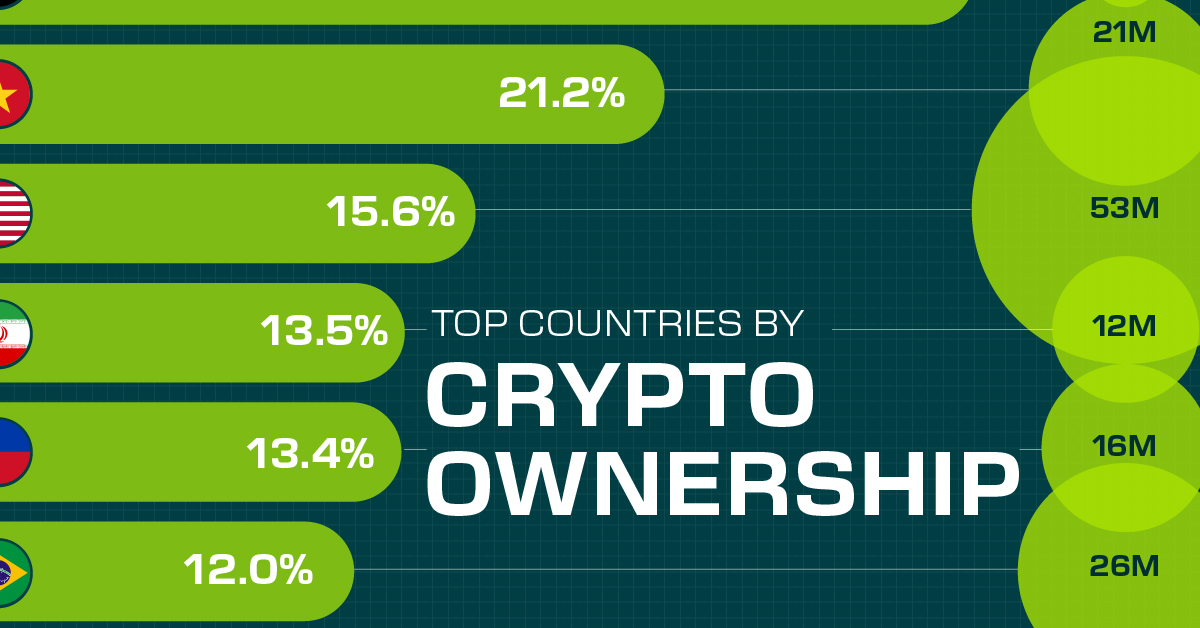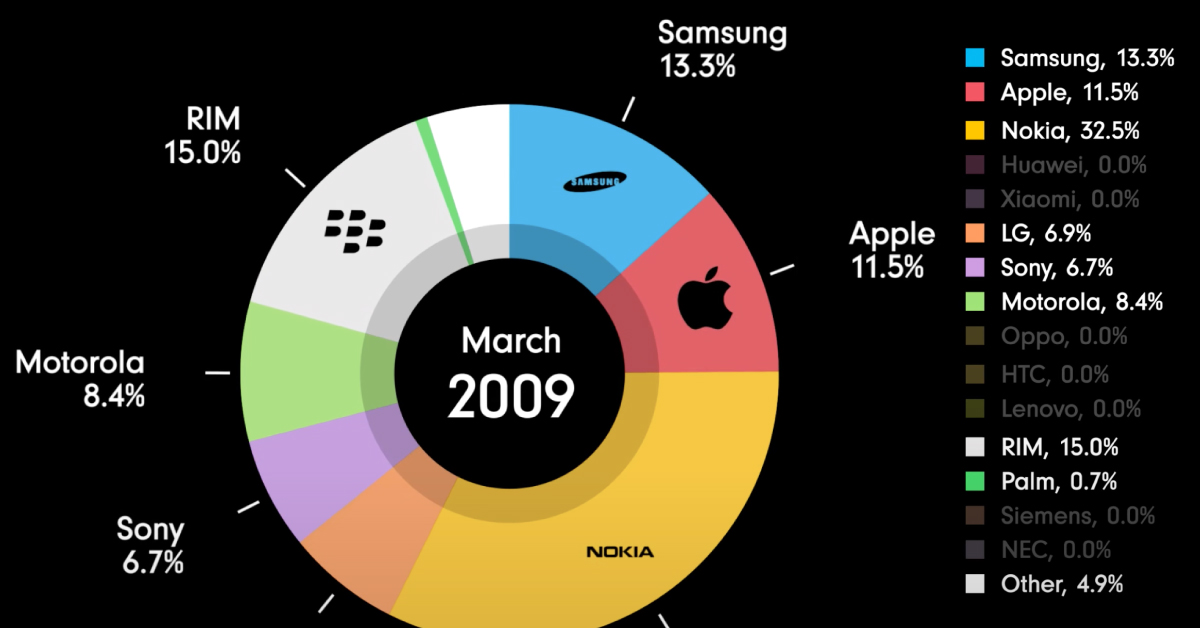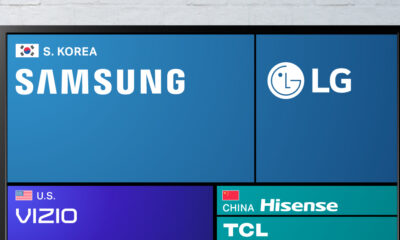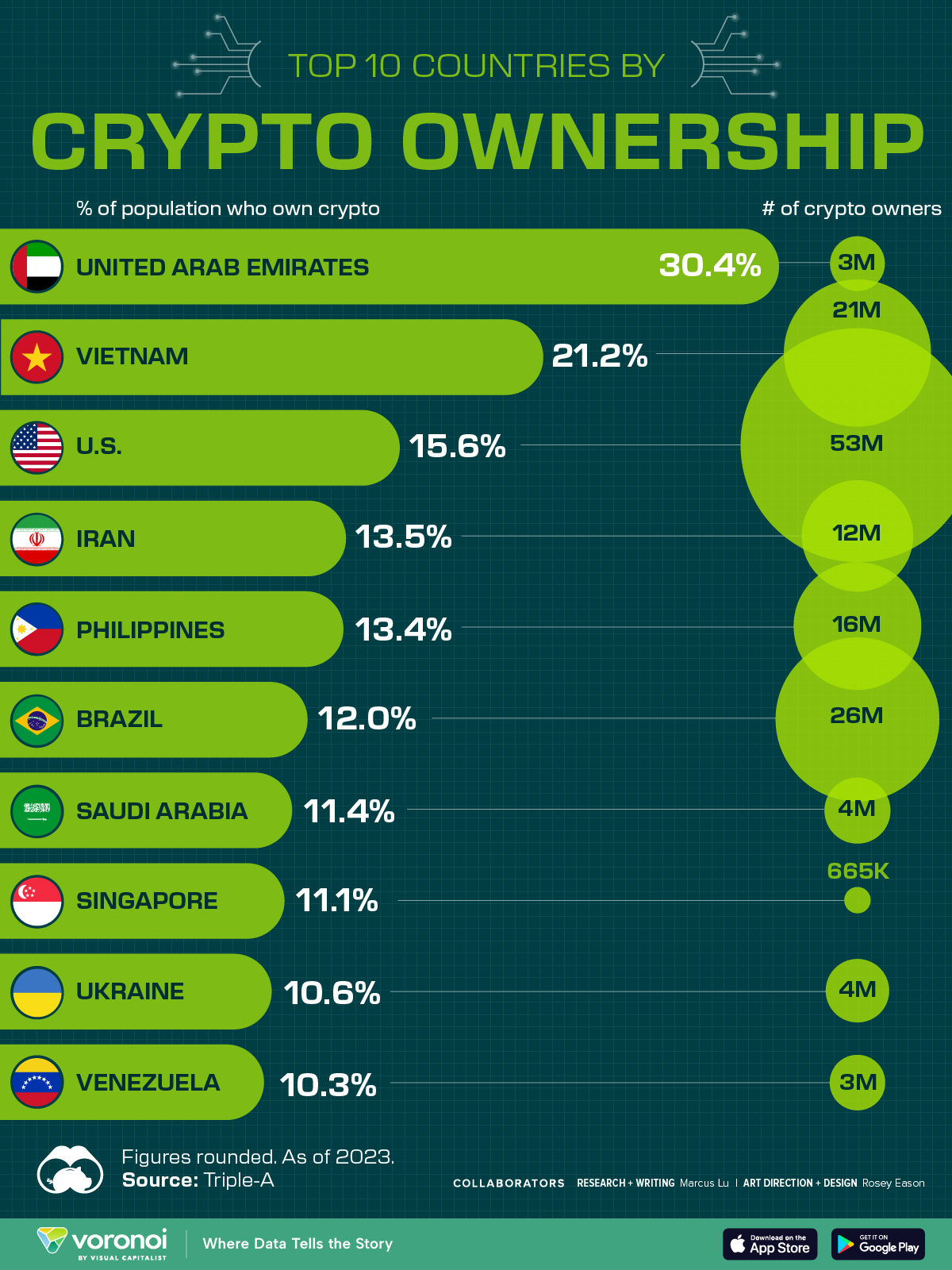Technology
Animation: How the Mobile Phone Market Has Evolved Over 30 Years
How The Mobile Phone Market Has Evolved Since 1993
The mobile phone landscape looks drastically different today than it did three decades ago.
In 1993, Motorola accounted for more than half of the mobile phone market. But by 2021, its market share had shrunk to just 2.2%. How did this happen, and how has the mobile industry changed over the last 30 years?
This video by James Eagle chronicles the evolution of the mobile phone market, showing the rise and fall of various mobile phone manufacturers. The data spans from December 1992 to December 2021.
The Early Days of Mobile Phones
Motorola is known for being a pioneer in the mobile phone industry.
In 1983, the American company launched one of the world’s first commercially available mobile phones—the DynaTAC 8000X. The revolutionary analog phone cost nearly $4,000 and offered users up to 30 minutes of talk time before needing to be recharged.
Motorola went on to launch a few more devices over the next few years, like the MicroTAC 9800X in 1989 and the International 3200 in 1992, and quickly became a dominant player in the nascent industry. In the early days of the market, the company’s only serious competitor was Finnish multinational Nokia, which had acquired the early mobile network pioneer Mobira.
But by the mid-1990s, other competitors like Sony and Siemens started to gain some solid footing, which chipped away at Motorola’s dominance. In September 1995, the company’s market share was down to 32.1%.
| Mobile Phone Market Share by Company | % Share (Sept. 1995) |
|---|---|
| Motorola | 32.1% |
| Nokia | 22.0% |
| Sony | 10.7% |
| NEC | 9.2% |
| Siemens | 2.1% |
| Samsung | 0.4% |
| Other | 23.5% |
By January 1999, Nokia surpassed Motorola as the leading mobile phone manufacturer, accounting for 21.4% of global market share. That put it just slightly ahead of Motorola’s 20.8%.
One of the reasons for Nokia’s surging popularity was the major headway the company was making in the digital phone space. In 1999, the company released the Nokia 7110, the first mobile phone to have a web browser.
But it wasn’t just Nokia’s innovations that were hampering Motorola. In 1999, Motorola fell on hard times after one of its spin-off projects called Iridium SSC filed for bankruptcy. This put a massive financial strain on the company, and it eventually laid off a large chunk of its workforce after the project failed.
From then on, Motorola’s market share hovered between 14% and 20%, until Apple’s iPhone entered the scene in 2007 and turned the mobile phone industry on its head.
The Emergence of the iPhone
Things really started to change with the launch of the iPhone in 2007.
In a keynote presentation at the San Francisco Macworld Expo in 2007, Steve Jobs presented the iPhone as three products wrapped into one device: a touchscreen iPod, a revolutionary cell phone, and an internet communications device.
One year later, Apple launched the App Store, which gave users the ability to download applications and games onto their iPhones. Not only did this greatly enhance the iPhone’s functionality, but it also allowed consumers to customize their mobile devices like never before.
This was the start of a new era of smartphones—one that Motorola failed to keep up with. Less than two years after the iPhone launched, Apple had captured 17.4% of the mobile phone market. In contrast, Motorola’s market share had shrunk down to 4.9%.
By the end of 2021, Apple held about 27.3% of the global mobile market. The iPhone is a key part of the tech giant’s growth, driving more than 50% of the company’s overall revenue.
A Failure to Pivot
While a number of factors contributed to Motorola’s downfall, many point to one central hurdle—the company’s failure to pivot.
The iPhone’s emergence was the start of a new, software-driven era. Motorola had mastered the hardware-driven era, but failed to keep up when the tides changed. And the animation above highlights other companies that also failed to adapt or keep up, including BlackBerry (formerly RIM), Palm, Sony, and LG.
But Apple is not alone. The popularity of Google’s Android mobile operating system has helped competitors like South Korea’s Samsung and China’s Huawei and Xiaomi flourish, with each company establishing strong footholds in the global mobile phone market.
In today’s fast-paced world, the ability to pivot is essential if businesses want to remain competitive. Will today’s mobile phone giants like Apple and Samsung remain on top? Or will other companies like Huawei catch up in the next few years?

This article was published as a part of Visual Capitalist's Creator Program, which features data-driven visuals from some of our favorite Creators around the world.
Technology
Countries With the Highest Rates of Crypto Ownership
While the U.S. is a major market for cryptocurrencies, two countries surpass it in terms of their rates of crypto ownership.

Countries With the Highest Rates of Crypto Ownership
This was originally posted on our Voronoi app. Download the app for free on iOS or Android and discover incredible data-driven charts from a variety of trusted sources.
This graphic ranks the top 10 countries by their rate of cryptocurrency ownership, which is the percentage of the population that owns crypto. These figures come from crypto payment gateway, Triple-A, and are as of 2023.
Data and Highlights
The table below lists the rates of crypto ownership in the top 10 countries, as well as the number of people this amounts to.
| Country | % of Population Who Own Crypto | # of Crypto Owners |
|---|---|---|
| 🇦🇪 United Arab Emirates | 30.4 | 3M |
| 🇻🇳 Vietnam | 21.2 | 21M |
| 🇺🇸 U.S. | 15.6 | 53M |
| 🇮🇷 Iran | 13.5 | 12M |
| 🇵🇭 Philippines | 13.4 | 16M |
| 🇧🇷 Brazil | 12 | 26M |
| 🇸🇦 Saudi Arabia | 11.4 | 4M |
| 🇸🇬 Singapore | 11.1 | 665K |
| 🇺🇦 Ukraine | 10.6 | 4M |
| 🇻🇪 Venezuela | 10.3 | 3M |
Note that if we were to rank countries based on their actual number of crypto owners, India would rank first at 93 million people, China would rank second at 59 million people, and the U.S. would rank third at 52 million people.
The UAE Takes the Top Spot
The United Arab Emirates (UAE) boasts the highest rates of crypto ownership globally. The country’s government is considered to be very crypto friendly, as described in Henley & Partners’ Crypto Wealth Report 2023:
In the UAE, the Financial Services Regulatory Authority (FSRA-ADGM) was the first to provide rules and regulations regarding cryptocurrency purchasing and selling. The Emirates are generally very open to new technologies and have proposed zero taxes for crypto owners and businesses.
Vietnam leads Southeast Asia
According to the Crypto Council for Innovation, cryptocurrency holdings in Vietnam are also untaxed, making them an attractive asset.
Another reason for Vietnam’s high rates of ownership could be its large unbanked population (people without access to financial services). Cryptocurrencies may provide an alternative means of accessing these services without relying on traditional banks.
Learn More About Crypto From Visual Capitalist
If you enjoyed this post, be sure to check out The World’s Largest Corporate Holders of Bitcoin, which ranks the top 12 publicly traded companies by their Bitcoin holdings.
-

 Personal Finance1 week ago
Personal Finance1 week agoVisualizing the Tax Burden of Every U.S. State
-

 Misc6 days ago
Misc6 days agoVisualized: Aircraft Carriers by Country
-

 Culture6 days ago
Culture6 days agoHow Popular Snack Brand Logos Have Changed
-

 Mining1 week ago
Mining1 week agoVisualizing Copper Production by Country in 2023
-

 Misc1 week ago
Misc1 week agoCharted: How Americans Feel About Federal Government Agencies
-

 Healthcare1 week ago
Healthcare1 week agoWhich Countries Have the Highest Infant Mortality Rates?
-

 Demographics1 week ago
Demographics1 week agoMapped: U.S. Immigrants by Region
-

 Maps1 week ago
Maps1 week agoMapped: Southeast Asia’s GDP Per Capita, by Country













